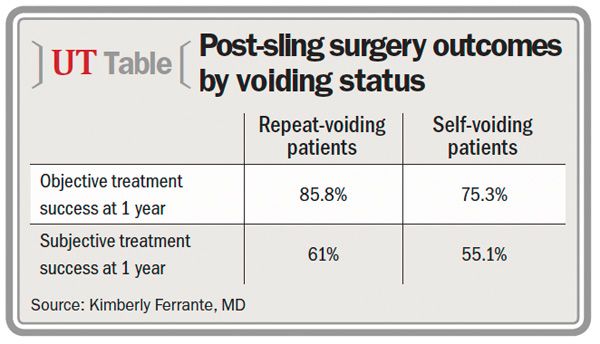Article
Need for post-sling voiding trial may be beneficial
Author(s):
Need for a repeat voiding trial after midurethral sling surgery does not increase the likelihood of a suboptimal outcome and may even predict a better long-term result, say researchers from the Urinary Incontinence Treatment Network.
San Diego-Need for a repeat voiding trial after midurethral sling surgery does not increase the likelihood of a suboptimal outcome and may even predict a better long-term result, say researchers from the Urinary Incontinence Treatment Network.

One year after surgery, significantly more patients who required a repeat postoperative voiding trial met objective criteria for success compared with patients who passed the initial voiding trial. Women who required a repeat voiding trial also were more likely to rate their procedure as successful.
“The results of the study will allow us to counsel our patients, and although they may be upset about going home with a catheter, their surgical outcome will not be compromised and they may in fact do even better, as we found a 10% difference at 1 year,” said first author Kimberly Ferrante, MD, a fellow in female pelvic medicine and reconstructive surgery at the University of California, San Diego, who presented the findings at the AUA annual meeting in San Diego.
“We also know from the analysis of urodynamic measures that those patients who require a repeat voiding trial do not show greater signs of obstruction than those who were self-voiding at discharge. Therefore, it is important not to change surgical technique,” added Dr. Ferrante, who worked on the study with Charles Nager, MD, and co-authors.
One-fourth of patients who undergo midurethral sling surgery may go home with a catheter because of an unsuccessful initial voiding trial. These patients require a repeat voiding trial after discharge. Whether the need for a second voiding trial predicts the outcome of midurethral sling surgery remains unclear.
To examine the relationship between initial voiding success and subsequent procedural success, Dr. Ferrante and colleagues analyzed data from the Trial of Midurethral Slings (TOMUS) study. The investigators hypothesized that women who required a repeat voiding trial would have better objective and subjective outcomes at 1 year, as compared with patients who were self-voiding and did not require a catheter at discharge.
In the TOMUS study, 597 women were randomized to retropubic versus transobturator slings. The need for a repeat voiding trial was defined by a post-void residual volume >100 mL or >1/3 total bladder volume and discharge with a catheter.
Objective treatment success at 1 year was defined as a negative provocative stress test at 300 mL, a negative 24-hour pad test, and no retreatment for stress urinary incontinence (SUI). Subjective success consisted of a lack of self-reported SUI symptoms, lack of leakage by a 3-day voiding diary, and no SUI retreatment.
86% success rate at 1 year
The results showed that 143 patients required a repeat voiding trial, and 454 went home without a catheter. At the 1-year follow-up, 85.8% of the repeat-voiding group met objective criteria for treatment success compared with 75.3% of the self-voiding group (p=.01). Subjective success rates were 61% for the repeat-voiding group and 55.1% for the self-voiding group, a difference that did not achieve statistical significance.
In a multivariate analysis, the need for a repeat voiding trial almost doubled the odds of objective success at 1 year (OR 1.82, p=.04). Increasing pad weight, previous incontinence surgery, and cotton-tipped swab maximum straining <30 were negative predictors of objective success.UT
Subscribe to Urology Times to get monthly news from the leading news source for urologists.
















